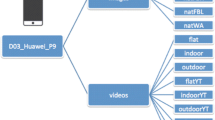Abstract
In this paper is presented an extended experimental evaluation of one of the most effective source camera identification techniques proposed so far, by Lukáš et al. (IEEE Trans Inf Forensics Security 1(2):205–214, 2006). This method uses the characteristic noise left by the sensor on a digital picture as a fingerprint in order to identify the source camera used to take the picture. The aim of the experiments is to assess the effectiveness of this technique when used with pictures that were previously modified using several common image-processing functions coming with photo-editing tools. Moreover, the technique is applied to photos passed through Online Social Networks or Online Photo Sharing websites, without any “human” explicit modification but only elaborated by such Web 2.0 tools. The results confirm that, in several cases, the method by Lukáš et al. (IEEE Trans Inf Forensics Security 1(2):205–214, 2006) is resilient to the modifications introduced by the considered image-processing functions. However, in the experiments it has been possible to identify several cases where the quality of the identification process deteriorated because of the noise introduced by the image-processing. In addition, when dealing with Online Social Networks and Online Photo Sharing services, it has been noted that some of them process and modify the uploaded pictures. These modifications make ineffective, in many cases, the method by Lukáš et al. (IEEE Trans Inf Forensics Security 1(2):205–214, 2006)


Similar content being viewed by others
References
Adobe Systems Inc (2010) http://www.adobe.com/products/photoshop/
Bayram S, Sencar HT, Memon ND, Avcibas I (2005) Source camera identification based on CFA interpolation. In: Proceedings of International Conference on Image Processing 2005, pp 69–72
Camera Imaging Products Association (2011) http://cipa.jp/english/index.html
Camera Labs (2010) http://www.cameralabs.com/reviews/Canon_EOS_1000D_Rebel_XS/verdict.shtml
Chen M, Fridrich JJ, Goljan M, Lukás J (2008) Determining image origin and integrity using sensor noise. IEEE Trans Inf Forensics Security 3(1):74–90
Choi KS, Lam EY, Wong KKY (2006) Source camera identification using footprints from lens aberration. In: Sampat N, DiCarlo JM, Martin RA (eds) Society of Photo-Optical Instrumentation Engineers (SPIE) Conference Series, vol 6069, pp 172–179. doi:10.1117/12.649775
Goljan M, Fridrich J, Filler T (2009) Large scale test of sensor fingerprint camera identification. In: Society of Photo-Optical Instrumentation Engineers (SPIE) Conference Series, vol 7254. doi:10.1117/12.805701
Google Picasa (2010) http://picasatutorials.com/2009/04/picasa-tip-im-feeling-lucky/
Holst GC (1996) CCD arrays, cameras, and displays. JCD Pub, SPIE Optical Engineering Press, Bellingham. ISBN: 978-0819428530
Janesick JR, Blouke M (1995) Scientific charge-coupled devices: past, present, and future. Opt Photon News 6(4):16–20
Kharrazi M, Sencar HT, Memon ND (2004) Blind source camera identification. In: ICIP, pp 709–712
Kivanc Mihcak M, Kozintsev I, Ramchandran K (1999) Spatially adaptive statistical modeling of wavelet image coefficients and its application to denoising. In: ICASSP 1999: Proceedings of the Acoustics, Speech, and Signal Processing, IEEE International Conference, IEEE Computer Society, Washington, DC, pp 3253–3256. doi:http://dx.doi.org/10.1109/ICASSP.1999.757535
Long Y, Huang Y (2006) Image based source camera identification using demosaicking. In: 2006 IEEE 8th Workshop on Multimedia Signal Processing, pp 419–424. doi:10.1109/MMSP.2006.285343
Lukáš J, Fridrich JJ, Goljan M (2006) Digital camera identification from sensor pattern noise. IEEE Trans Inf Forensics Security 1(2):205–214
MathWorks (2010) http://www.mathworks.com/products/matlab/
Photobucket Statistics (2011) Service description. http://photobucket.com/about
Acknowledgments
The authors would like to thank the chief of the CNCPO, V.Q.A. Dr. Elvira D’Amato, along with her group, for their valuable suggestions during the research phases. Their needs, questions and doubts coming from real and day-by-day investigations have encouraged the authors to further improve this work. A sincere thanks goes to the group of undergraduates who helped carry out the study.
Author information
Authors and Affiliations
Corresponding author
Additional information
The project is a joint work with the CNCPO (Centro Nazionale per il Contrasto della Pedopornografia Online), part of the “Dipartimento della Pubblica Sicurezza” within the Italian Ministry of Interior. A preliminary version of this paper appeared in the International Workshop on Cloud, Wireless and e-Commerce Security (CWECS 2010) held in Fukuoka, November 4–6, 2010.
Rights and permissions
About this article
Cite this article
Castiglione, A., Cattaneo, G., Cembalo, M. et al. Experimentations with source camera identification and Online Social Networks. J Ambient Intell Human Comput 4, 265–274 (2013). https://doi.org/10.1007/s12652-011-0070-2
Received:
Accepted:
Published:
Issue Date:
DOI: https://doi.org/10.1007/s12652-011-0070-2




